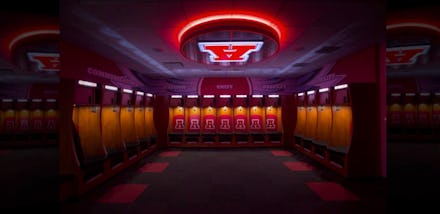A $662,000 Basketball Locker Room Is Raising a Lot of Questions About High School Sports

Is this a high school locker room or an NBA practice facility?
At Arrowhead Union High School in Hartland, Wisconsin, a lavish $662,000 new locker room for the men's and women's basketball team is turning heads — and attracting criticism for what seems like misuse of public funds.
Critics say this is too much money to spend on one athletic facility that benefits just a small percentage of the school's roughly 2,300 students. "We need to keep these kids focused on doing everything we possibly can to lift up everybody in the school district," local parent George Fuller told WISN. "And I'm sure that money could be spent helping other kids to advance their education."
"It just seems like a lot of money for a high school locker room," said parent Phil Ekins.
According to Sports Illustrated, the total cost of the facility was $662,602, of which $280,726 came from the school and $361,224 came from an anonymous benefactor.
The school's side of the story: Superintendent Craig Jefson told Mic that the school already spends just under $1 million annually supporting 33 varsity sports and more than 90 others out of a general fund of approximately $25 million.
"A donor came forward with a concept or an idea that he wanted a pretty lavish locker room," Jefson told Mic. "The board's interest in doing this project is that this locker room, the sewers were backing up, the toilets didn't work." He added that the facility had not received any major renovations or upgrades since the 1970s and was a "pretty nasty-looking area. The HVAC did not work properly. We'd already identified that as part of a facilities project."
Jefson said that the school was obligated to deal with these infrastructure issues and that the cost of the renovations sans the "glitzy" decor came to "low end, $560,000." He said that the donor actually saved taxpayer money by offsetting the cost of the new facilities, and that the extra money for decor was provided out of pocket by the anonymous benefactor. The high cost of the project might make more financial sense, Jefson said, when considering that it would probably remain in use for the next three to four decades and would be used by multiple sports teams.
"It's a very nice facility. There isn't any doubt that it is a very flashy area. I get peoples' concerns," Jefson said. "It's very expensive to do bathrooms. We were talking about asbestos being there. It wasn't, 'Let's put in this glitzy wonderful thing.'"
"We're routinely recognized for our state and national test scores. It's a high-performing school," he said. "I am surprised that it's become national news."
But schools do spend too much on athletics: They've been doing it for a long time too, though football is usually the culprit. In 2004, USA Today found evidence of overspending on high school sports programs "from South Carolina to Michigan, from Louisiana to Minnesota, from Georgia and Indiana to the high school football holy land of Texas." Of the 13,580 high schools playing 11-man football in 2003, USA Today found that Valdosta (Georgia) spent $319,000, West Monroe (Louisiana) spent nearly $300,000 and the rest averaged $61,000.
"Taxpayers go, 'Wait a minute. You say we don't have enough money, but we've got these huge stadiums and we're paying these great stipends to coaches,'" Texas University Interscholastic League then-athletics director Charles Breithaupt told USA Today. "Those issues come up in front of the legislature from time to time, and it's important for our schools to take note of that."
...and specifically on lavish facilities: One investigation by the Coloradoan found that at Fort Collins High School in Fort Collins, Colorado, athletic spending was about $760 per student athlete, compared to less than $500 per student in English, math or science. The city's three other major high schools recorded similar spending. Public schools in New Jersey spend more than $200 million annually on sports.
The Atlantic's Amanda Ripley writes that U.S. high schools' obsession with sports is an international anomaly, with nearly 9 out of 10 of some 200 foreign students she surveyed reporting that students in the U.S. devote more time and energy to sports than those in their home countries. She adds:
Some schools hire professional coaches at full salaries, or designate a teacher as the full-time athletic director. New bleachers can cost half a million dollars, about the same as artificial turf. Even maintaining a grass field can cost more than $20,000 a year. Reconditioning helmets, a ritual that many teams pay for every year, can cost more than $1,500 for a large team. Some communities collect private donations or levy a special tax to fund new school-sports facilities.
All this spending takes place against a dim backdrop for funding of other programs like reading, writing and math. Nationally, per-pupil spending plummeted in 2011 and 2012 (the last years for which data are available from the National Center for Education Statistics). At an average spending level of $10,667 per pupil nationwide, the $660,000 locker room would fund approximately other 62 students' annual education.
Even if Jefson is right that this project was less expensive than it could have been, there's still the larger question of allocating resources in the country's public school systems. It should come as no surprise that American students are far from the best in the world, so justifying such aggressive spending for high school athletics is dubious at best. Though high school sports certainly have their benefits, one has to wonder whether they really merit a $660,000 price tag.